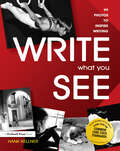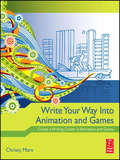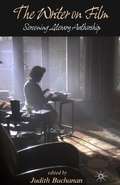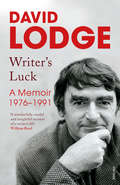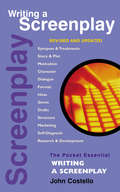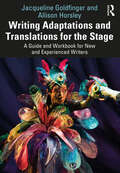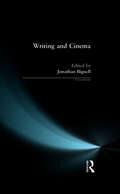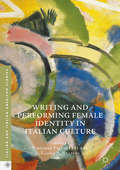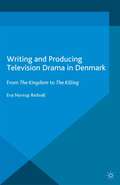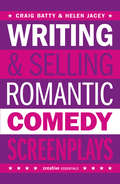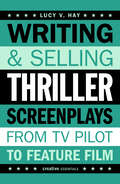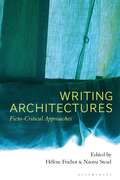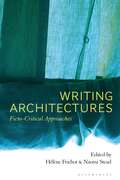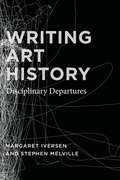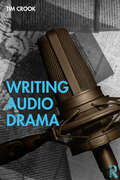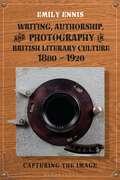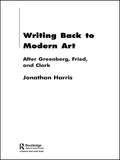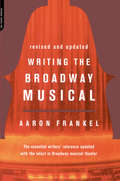- Table View
- List View
Write What You See: 99 Photos to Inspire Writing (Grades 7-12)
by Hank KellnerMotivate your students with the wide variety of photographs and writing prompts in this delightful book by award-winning photographer and former English teacher Hank Kellner.The varied prompts include key words, questions to consider, ideas for writing, possible opening lines, suggestions for research, and more. The book even comes with a CD so that you have the option of displaying the activities with an overhead projector.Write What You See contains a wealth of ideas for writing from the author as well as from real teachers across the country who have successfully used photography in the teaching of writing.Grades 7-12
Write Your Way into Animation and Games: Create a Writing Career in Animation and Games
by Christy MarxLaunch your career in writing for video games or animation with the best tips, tricks, and tutorials from the Focal press catalog--all at your fingertips. Let our award-winning writers and game developers show you how to generate ideas and create compelling storylines, concepts, and narratives for your next project. Write Your Way Into Animation and Games provides invaluable information on getting into the game and animation industries. You will benefit from decades of insider experience about the fields of animation and games, with an emphasis on what you really need to know to start working as a writer. Navigate the business aspects, gain unique skills, and develop the craft of writing specifically for aniamtion and games. Learn from the cream of the crop who have shared their knowledge and experience in these key Focal Press guides: Digital Storytelling, Second Edition by Carolyn Handler Miller Animation Writing and Development by Jean Ann Wright Writing for Animation, Comics, and Games by Christy Marx Story and Simulations for Serious Games by Nick Iuppa and Terry Borst Writing for Multimedia and the Web, Third Edition by Timothy Garrand
Write Your Way into Animation and Games: Create a Writing Career in Animation and Games
by Christy MarxLaunch your career in writing for video games or animation with the best tips, tricks, and tutorials from the Focal press catalog--all at your fingertips. Let our award-winning writers and game developers show you how to generate ideas and create compelling storylines, concepts, and narratives for your next project. Write Your Way Into Animation and Games provides invaluable information on getting into the game and animation industries. You will benefit from decades of insider experience about the fields of animation and games, with an emphasis on what you really need to know to start working as a writer. Navigate the business aspects, gain unique skills, and develop the craft of writing specifically for aniamtion and games. Learn from the cream of the crop who have shared their knowledge and experience in these key Focal Press guides: Digital Storytelling, Second Edition by Carolyn Handler Miller Animation Writing and Development by Jean Ann Wright Writing for Animation, Comics, and Games by Christy Marx Story and Simulations for Serious Games by Nick Iuppa and Terry Borst Writing for Multimedia and the Web, Third Edition by Timothy Garrand
The Writer on Film: Screening Literary Authorship
by Judith BuchananExamining films about writers and acts of writing, The Writer on Film brilliantly refreshes some of the well-worn 'adaptation' debates by inviting film and literature to engage with each other trenchantly and anew – through acts of explicit configuration not adaptation.
Writer's Luck: A Memoir: 1976-1991
by David LodgeDavid Lodge’s frank and illuminating memoir about the years where he found great success as a novelist and critic.Luck plays an important part in the careers of writers. In this book David Lodge explores how his work was inspired and affected by unpredictable events in his life. In 1976 Lodge was pursuing a ‘twin-track career’ as novelist and academic. As a literary critic, he made serious contributions to the subject, before carnivalising it in his comic-satiric novel Small World. The balancing act between his two professions was increasingly difficult to maintain, and he became a full-time writer just before he published his bestselling novel Nice Work. Both books were shortlisted for the Booker Prize, in which he was later involved as Chairman of the judges.Readers of Lodge’s novels will be fascinated by the insights this book gives – not only into his professional career but also more personal experience. The main focus, however, is on writing as a vocation. Anyone who is interested in learning about the creative process, about the dual nature of the novel as both work of art and commodity, will find Writer’s Luck a candid and entertaining guide.
Writing a Screenplay (Pocket Essentials Ser.)
by John CostelloThe recent explosion of unsolicited material written for the world's greatest, sexiest entertainment medium has largely produced a mountain of wasted paper. Truth is, the many who write from scratch, no matter how talented, have more chance of winning the lottery than creating an excellent script. The few who achieve success do so because they have shed the blood, sweat and tears necessary to master the elaborate art and craft of Screenwriting. This book explodes the myth that a screenplay is the easiest literary form to master, navigates a relatively painless path through the Screenwriting labyrinth, and offers an easy to digest step-by-step guide to writing a script from inception to completion. What's in it? The main areas covered are: Motivation; Research & Development; Genre; Idea; Story & Plot; Audience; Character; Action & Setting; Structure; Format; Dialogue; Synopses & Treatments; Drafts; Marketing & The Industry. There's also a glossary of commonly used jargon to further demystify the process.
Writing Adaptations and Translations for the Stage: A Guide and Workbook for New and Experienced Writers
by Jacqueline Goldfinger Allison HorsleyWriting Adaptations and Translations for the Stage is a practical guide for writing adapted works for theatrical performance.Broadway translator and dramaturg Allison Horsley and award-winning playwright and educator Jacqueline Goldfinger take readers step-by-step through the brainstorming, writing, revision, and performance processes for translations and adaptations. The book includes lectures, case studies, writing exercises, and advice from top theater professionals on the process of creating, pitching, and producing adaptations and translations, covering a wide range of topics such as jukebox musicals, Shakespeare adaptations, plays from novels, theater for young adults, and theater in translation and using Indigenous language. Artists who share their wisdom in this book include: Des McAnuff (Tony Award), Emily Mann (Tony Award), Dominique Morisseau (Broadway Adaptor, Tony Award nominee, MacArthur Genius Fellow), Lisa Peterson (Obie Award, Lortel Award), Sarah Ruhl (Broadway Playwright, Tony Award nominee, Pulitzer Prize finalist, MacArthur Genius Fellow), and Tina Satter (Broadway Director, Obie Award, Guggenheim Fellowship). The book also features interviews with artists working both in the US and internationally, as well as guest columns from artists who work in less traditional adaptive forms including cabaret, burlesque, opera, community-engaged process, and commercial theater.Writing Adaptations and Translations for the Stage is an essential resource for students and instructors of Dramatic Writing, Playwriting, and Creative Writing courses and for aspiring playwrights.
Writing Adaptations and Translations for the Stage: A Guide and Workbook for New and Experienced Writers
by Jacqueline Goldfinger Allison HorsleyWriting Adaptations and Translations for the Stage is a practical guide for writing adapted works for theatrical performance.Broadway translator and dramaturg Allison Horsley and award-winning playwright and educator Jacqueline Goldfinger take readers step-by-step through the brainstorming, writing, revision, and performance processes for translations and adaptations. The book includes lectures, case studies, writing exercises, and advice from top theater professionals on the process of creating, pitching, and producing adaptations and translations, covering a wide range of topics such as jukebox musicals, Shakespeare adaptations, plays from novels, theater for young adults, and theater in translation and using Indigenous language. Artists who share their wisdom in this book include: Des McAnuff (Tony Award), Emily Mann (Tony Award), Dominique Morisseau (Broadway Adaptor, Tony Award nominee, MacArthur Genius Fellow), Lisa Peterson (Obie Award, Lortel Award), Sarah Ruhl (Broadway Playwright, Tony Award nominee, Pulitzer Prize finalist, MacArthur Genius Fellow), and Tina Satter (Broadway Director, Obie Award, Guggenheim Fellowship). The book also features interviews with artists working both in the US and internationally, as well as guest columns from artists who work in less traditional adaptive forms including cabaret, burlesque, opera, community-engaged process, and commercial theater.Writing Adaptations and Translations for the Stage is an essential resource for students and instructors of Dramatic Writing, Playwriting, and Creative Writing courses and for aspiring playwrights.
Writing and Cinema (Crosscurrents)
by Jonathan BignellThis collection of essays examines the ways in which writing and cinema can be studied in relation to each other. A wide range of material is presented, from essays which look at particular films, including The Piano and The English Patient, to discussions of the latest developments in film studies including psychoanalytic film theory and the cultural study of film audiences. Specific topics that the essays address also include: the kinds of writing produced for the cinema industry, advertising, film adaptations of written texts and theatre plays from nineteenth century 'classic' novels to recent cyberpunk science fiction such as Blade Runner and Starship Troopers. The essays deal with existing areas of debate, like questions of authorship and audience, and also break new ground, for example in proposing approaches to the study of writing on the cinema screen. The book includes a select bibliography, and a documents section gives details of a range of films for further study.
Writing and Cinema (Crosscurrents)
by Jonathan BignellThis collection of essays examines the ways in which writing and cinema can be studied in relation to each other. A wide range of material is presented, from essays which look at particular films, including The Piano and The English Patient, to discussions of the latest developments in film studies including psychoanalytic film theory and the cultural study of film audiences. Specific topics that the essays address also include: the kinds of writing produced for the cinema industry, advertising, film adaptations of written texts and theatre plays from nineteenth century 'classic' novels to recent cyberpunk science fiction such as Blade Runner and Starship Troopers. The essays deal with existing areas of debate, like questions of authorship and audience, and also break new ground, for example in proposing approaches to the study of writing on the cinema screen. The book includes a select bibliography, and a documents section gives details of a range of films for further study.
Writing and Performing Female Identity in Italian Culture
by Virginia Picchietti Laura A. SalsiniThis volume investigates the ways in which Italian women writers, filmmakers, and performers have represented female identity across genres from the immediate post-World War II period to the turn of the twenty-first century. Considering genres such as prose, poetry, drama, and film, these essays examine the vision of female agency and self-actualization arising from women artists’ critique of female identity. This dual approach reveals unique interpretations of womanhood in Italy spanning more than fifty years, while also providing a deep investigation of the manipulation of canvases historically centered on the male subject. With its unique coupling of generic and thematic concerns, the volume contributes to the ever expanding female artistic legacy, and to our understanding of postwar Italian women’s evolving relationship to the narration of history, gender roles, and these artists’ use and revision of generic convention to communicate their vision.
Writing and Performing Female Identity in Italian Culture
by Virginia Picchietti Laura A. SalsiniThis volume investigates the ways in which Italian women writers, filmmakers, and performers have represented female identity across genres from the immediate post-World War II period to the turn of the twenty-first century. Considering genres such as prose, poetry, drama, and film, these essays examine the vision of female agency and self-actualization arising from women artists’ critique of female identity. This dual approach reveals unique interpretations of womanhood in Italy spanning more than fifty years, while also providing a deep investigation of the manipulation of canvases historically centered on the male subject. With its unique coupling of generic and thematic concerns, the volume contributes to the ever expanding female artistic legacy, and to our understanding of postwar Italian women’s evolving relationship to the narration of history, gender roles, and these artists’ use and revision of generic convention to communicate their vision.
Writing and Producing Television Drama in Denmark: From The Kingdom to The Killing (Palgrave Studies in Screenwriting)
by Eva Novrup RedvallOffering unique insights into the writing and production of television drama series such as The Killing and Borgen, produced by DR, the Danish Broadcasting Corporation, Novrup Redvall explores the creative collaborations in writers' rooms and 'production hotels' through detailed case studies of Denmark's public service production culture.
Writing and Selling Romantic Comedy Screenplays: A Screenwriter's Guide to the RomCom Genre (Writing And Selling Screenplays Ser.)
by Helen JaceyWhat happens when ‘happy ever after’ isn’t quite so simple?Today’s attitudes to love and romance are as varied and diverse as individuals, and audiences want and need more sophisticated, authentic films that show how we live and love now. So what does this mean for the screenwriter developing a romcom? And how do they write heart-warming stories for a genre that is constantly evolving, from bromcom to zomcom to famcom?Writing and Selling Romantic Comedy Screenplays offers a fresh approach to creating narratives for this ever-changing genre. Moving away from rigid and limited definitions that have evolved out of mainstream genre films, the book embraces a working definition that crosses cultural and national boundaries to give screenwriters around the world a truly international perspective on writing comedic love stories.It is the first screenwriting guide to reflect the diversity of approaches in today’s films that deal with the human need for emotional and physical intimacy using humour – the contemporary romantic comedy.'Immensely helpful' - Divya Johry 'An excellent addition to the Creative Essentials screenwriting book family' - WritesSoFluidFeatures of the book include:Illuminating, challenging and provocative about the state of the rom-com genre. Why do some films feel so dated, while others are perennially relevant?Explores and defines all subgenres of romcom, such as zomcom, bromedy, soromcom and famcom.Uniquely draws on creativity, screenwriting genre theory and film industry practice. Stimulating creative exercises at the end of every chapter, and 'hot tips' throughout.Adaptable concepts that can be applied to both feature films and short films.Encourages screenwriters to define their own values about love to ensure their voice and message is original - and commercial.Case studies and analyses of produced screenplays, including Dostana, Due Date, I Give it a Year, I love You, Man, Midnight in Paris, Ruby Sparks, Tamara Drewe, Ted and Warm BodiesInterviews with writers, directors and producers.Genuine international perspectiveIndispensible guide for both the student and the professional writer or filmmaker.
Writing and Selling Thriller Screenplays: A Screenwriter's Guide for Film and Television (Writing And Selling Screenplays Ser.)
by Lucy V. HayWriting and Selling Thriller Screenplays has the lowdown not only on getting your thriller feature script on the page, but getting it in front of producers and investors.From premise to resolution, Lucy V. Hay guides you through the craft of thriller writing, citing classic thrillers such as Psycho, The Shining, The Sixth Sense and Fatal Attraction and lesser-known gems like Red Eye, Desperate Measures, Impostor and Deviation.The book also considers how the screenplay might be sold to investors, looking at high concept ideas, pitching, packaging and the realities of film finance.Lucy V. Hay asks: what is flight vs. fight? What is the difference between horror and thriller? What are the different sub genres of thriller? What part do actors play in film finance? How can limited locations create new opportunities in storytelling and financing? Why is the lone protagonist so in demand? Why are female characters so popular in thriller? And much, much more...'Really hones in on the specific genre of thrillers with expertise' - Write So Fluid'A must-read for any writer, producer or director looking to create (or in the process of creating) a thriller production. It could also be immensely useful for those generally curious about the genre or looking to learn more' - Film Doctor'This book should form part of the armoury for any screenplay writers bookshelf' - Stephen HallCheck out Lucy V. Hay's other screenwriting books: Writing & Selling Drama Screenplays and Writing Diverse Characters for Fiction, Film and TV
Writing Architectures: Ficto-Critical Approaches
by Hélène Frichot and Naomi SteadArchitects and fiction writers share the same ambition: to imagine new worlds into being. Every architectural proposition is a kind of fiction before it becomes a built fact; likewise, every written fiction relies on the construction of a context in which a story can take place. This collection of essays explores what happens when fiction, experimental writing and criticism are combined and applied to architectural projects and problems. It begins with ficto-criticism – an experimental and often feminist mode of writing which fuses the forms and genres of essay, critique, and story – and extends it into the domain of architecture, challenging assumptions about our contemporary social and political realities, and placing architecture in contact with such disciplines as cultural studies, literary theory and ethnography. These sixteen newly-written pieces have been selected for this volume to show how ficto-critical writing can be a powerful vehicle for creative architectural practice, providing new opportunities to explore modes of writing about architecture both within and beyond the discipline.The collection represents a broad range of geographical and cultural positions including indigenous and non-Western contexts, and includes a foreword and afterword by important thinkers in the domains of architectural criticism (Jane Rendell) and cultural studies/ethnography (Stephen Muecke).
Writing Architectures: Ficto-Critical Approaches
Architects and fiction writers share the same ambition: to imagine new worlds into being. Every architectural proposition is a kind of fiction before it becomes a built fact; likewise, every written fiction relies on the construction of a context in which a story can take place. This collection of essays explores what happens when fiction, experimental writing and criticism are combined and applied to architectural projects and problems. It begins with ficto-criticism – an experimental and often feminist mode of writing which fuses the forms and genres of essay, critique, and story – and extends it into the domain of architecture, challenging assumptions about our contemporary social and political realities, and placing architecture in contact with such disciplines as cultural studies, literary theory and ethnography. These sixteen newly-written pieces have been selected for this volume to show how ficto-critical writing can be a powerful vehicle for creative architectural practice, providing new opportunities to explore modes of writing about architecture both within and beyond the discipline.The collection represents a broad range of geographical and cultural positions including indigenous and non-Western contexts, and includes a foreword and afterword by important thinkers in the domains of architectural criticism (Jane Rendell) and cultural studies/ethnography (Stephen Muecke).
Writing Art History: Disciplinary Departures
by Stephen Melville Margaret IversenFaced with an increasingly media-saturated, globalized culture, art historians have begun to ask themselves challenging and provocative questions about the nature of their discipline. Why did the history of art come into being? Is it now in danger of slipping into obsolescence? And, if so, should we care? In Writing Art History, Margaret Iversen and Stephen Melville address these questions by exploring some assumptions at the discipline’s foundation. Their project is to excavate the lost continuities between philosophical aesthetics, contemporary theory, and art history through close readings of figures as various as Michael Baxandall, Martin Heidegger, Jacques Lacan, and Alois Riegl. Ultimately, the authors propose that we might reframe the questions concerning art history by asking what kind of writing might help the discipline to better imagine its actual practices—and its potential futures.
Writing Audio Drama
by Tim CrookWriting Audio Drama is a comprehensive and intelligent guide to writing sound drama for broadcasting and online production. The book uses new and original research on the history of writing radio plays in the UK and USA to explore how this has informed and developed the art form for more than 100 years. Audio drama in the context of podcasting is now experiencing a global and exponential expansion. Through analysis of examples of past and present writing, the author explains how to originate and craft drama which can explore deeply psychological and intimate themes and achieve emotional, truthful, entertaining, and thought-provoking impact. Practical analysis of the key factors required to write successful audio drama is covered in chapters focusing on audio play beginnings and openings, sound story dialogue, sustaining the sound story, plotting for sound drama and the best ways of ending audio plays. Each chapter is supported by extensive companion online resources expanding and supporting the writers and subjects discussed and explored, and extensive information on how to access online many exemplar and model sound dramas referenced in the chapters. This textbook will be an important resource for undergraduate and postgraduate students taking modules and courses on radio drama, theatre and media drama, audio theatre, audio drama, scriptwriting, media writing.
Writing Audio Drama
by Tim CrookWriting Audio Drama is a comprehensive and intelligent guide to writing sound drama for broadcasting and online production. The book uses new and original research on the history of writing radio plays in the UK and USA to explore how this has informed and developed the art form for more than 100 years. Audio drama in the context of podcasting is now experiencing a global and exponential expansion. Through analysis of examples of past and present writing, the author explains how to originate and craft drama which can explore deeply psychological and intimate themes and achieve emotional, truthful, entertaining, and thought-provoking impact. Practical analysis of the key factors required to write successful audio drama is covered in chapters focusing on audio play beginnings and openings, sound story dialogue, sustaining the sound story, plotting for sound drama and the best ways of ending audio plays. Each chapter is supported by extensive companion online resources expanding and supporting the writers and subjects discussed and explored, and extensive information on how to access online many exemplar and model sound dramas referenced in the chapters. This textbook will be an important resource for undergraduate and postgraduate students taking modules and courses on radio drama, theatre and media drama, audio theatre, audio drama, scriptwriting, media writing.
Writing, Authorship and Photography in British Literary Culture, 1880 - 1920: Capturing the Image
by Emily EnnisAt the turn of the 20th century, printing and photographic technologies evolved rapidly, leading to the birth of mass media and the rise of the amateur photographer. Demonstrating how this development happened symbiotically with great changes in the shape of British literature, Writing, Authorship and Photography in British Literary Culture, 1880-1920 explores this co-evolution, showing that as both writing and photography became tools of mass dissemination, literary writers were forced to re-evaluate their professional and personal identities. Focusing on four key authors-Thomas Hardy, Bram Stoker, Joseph Conrad and Virginia Woolf-each of which had their own private and professional connections to photographs, this book offers valuable historical contexts for contemporary cultural developments and anxieties. At first establishing the authors' response to developing technologies through their non-fiction, personal correspondences and working drafts, Ennis moves on to examine how their perceptions of photography extend into their major works of fiction: A Laodicean, Dracula, The Secret Agent, The Inheritors and The Voyage Out. Reflecting on the first 'graphic revolution' in a world where text and image are now reproduced digitally and circulated en masse and online, Ennis redirects our attention to when image and text appeared alongside each other for the first time and the crises this sparked for authors: how they would respond to increasingly photographic depictions of everyday life, and in turn, how their writing adapted to a distinctly visual mass media.
Writing, Authorship and Photography in British Literary Culture, 1880 - 1920: Capturing the Image
by Emily EnnisAt the turn of the 20th century, printing and photographic technologies evolved rapidly, leading to the birth of mass media and the rise of the amateur photographer. Demonstrating how this development happened symbiotically with great changes in the shape of British literature, Writing, Authorship and Photography in British Literary Culture, 1880-1920 explores this co-evolution, showing that as both writing and photography became tools of mass dissemination, literary writers were forced to re-evaluate their professional and personal identities. Focusing on four key authors-Thomas Hardy, Bram Stoker, Joseph Conrad and Virginia Woolf-each of which had their own private and professional connections to photographs, this book offers valuable historical contexts for contemporary cultural developments and anxieties. At first establishing the authors' response to developing technologies through their non-fiction, personal correspondences and working drafts, Ennis moves on to examine how their perceptions of photography extend into their major works of fiction: A Laodicean, Dracula, The Secret Agent, The Inheritors and The Voyage Out. Reflecting on the first 'graphic revolution' in a world where text and image are now reproduced digitally and circulated en masse and online, Ennis redirects our attention to when image and text appeared alongside each other for the first time and the crises this sparked for authors: how they would respond to increasingly photographic depictions of everyday life, and in turn, how their writing adapted to a distinctly visual mass media.
Writing Back to Modern Art: After Greenberg, Fried and Clark
by Jonathan HarrisHere for the first time is a full-length study of the 'critical modernisms' of the three leading art writers of the second half of the twentieth century, which helps us build a better understanding of the development of modern art writing and its relation to the 'post-modern' in art and society since the 1970s. Focusing on canonical modern artists such as Manet, Cezanne, Picasso and Pollock, this book provides an important understanding of writing and criticism in modern art for all students and scholars of art theory and art history. Mainstay issues discussed include aesthetic evaluation, subjectivity and meaning in art and art writing. Jonathan Harris examines key discourses and identifies points of significant overlap as well as sharp disjunction between the critics. Developing the notions of 'good' and 'bad' complexity in modernist criticism, Writing Back to Modern Art creates ways for us to think outside of these discourses of value and meaning and helps us to look at the place that art writing holds in the latter twentieth century and beyond.
Writing Back to Modern Art: After Greenberg, Fried and Clark
by Jonathan HarrisHere for the first time is a full-length study of the 'critical modernisms' of the three leading art writers of the second half of the twentieth century, which helps us build a better understanding of the development of modern art writing and its relation to the 'post-modern' in art and society since the 1970s. Focusing on canonical modern artists such as Manet, Cezanne, Picasso and Pollock, this book provides an important understanding of writing and criticism in modern art for all students and scholars of art theory and art history. Mainstay issues discussed include aesthetic evaluation, subjectivity and meaning in art and art writing. Jonathan Harris examines key discourses and identifies points of significant overlap as well as sharp disjunction between the critics. Developing the notions of 'good' and 'bad' complexity in modernist criticism, Writing Back to Modern Art creates ways for us to think outside of these discourses of value and meaning and helps us to look at the place that art writing holds in the latter twentieth century and beyond.
Writing The Broadway Musical
by Aaron FrankelBrimming with advice and techniques, this essential reference for book- and songwriters clearly explains the fundamentals of the three crafts of a musical-book, music, and lyrics. Using copious examples from classic shows, Frankel has created the quintessential musical writers' how-to. Among the topics:definitions of musical theater; differences between musical books and straight plays and between poetry and lyrics; what a score is and how it develops; how to write for the voice; and how to audition musicals for producers. With a new introduction and revised text, Frankel's work is ready to guide a new generation of aspiring writers.
